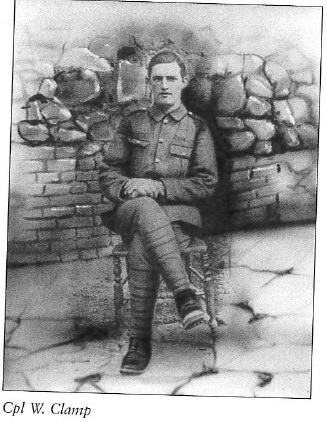Cpl
William Clamp
Informationen zu Geburt
|
Geburtsdatum: 28/10/1891 |
|
Geburtsort: Motherwell, Lanarkshire, Vereinigtes Königreich, Schottland |
Allgemeine Informationen
|
Beruf: Railroad Worker |
Informationen zum Armeedienst
|
Land: England, Vereinigtes Königreich |
|
Truppe: British Expeditionary Force |
|
Rang: Corporal |
|
Dienstnummer: 42537 |
|
Einheiten: — Alexandra Princess of Wales's Own (Yorkshire Regiment), 6th Bn. (Letzte bekannte Einheit) |
Informationen zu Tod
|
Sterbedatum: 09/10/1917 |
|
Sterbeort: The Brewery, Poelkapelle, Belgien |
|
Todesursache: Im Kampf gefallen |
|
Alter: 25 |
Gedenkstätte
|
Tyne Cot Memorial Tafel: 52 |
Auszeichnungen und Orden 3
|
British War Medal Medaille |
|
Victoria Cross Medaille — 18/12/1917 |
|
Victory Medal Medaille |
Punkte von Interesse 1
| #1 | Geburtsort |
Meine Geschichte
Corporal William Clamp served in the Yorkshire Regiment 6th Battalion (also known as the “Green Howards”, part of the 32nd Brigade of the 11th (Northern) Division. Before the Battle of Passchendaele in 1917 he was two times seriously wounded and then transferred to the 6th Green Howards. On the 7th of October 1917, the Battalion left Houtkerque by bus at 10 a.m. and arrived at the camps at 2 p.m. Once arrived the Battalion received orders to move up the line and relieve a Battalion of the 33rd Brigade that night. Due to the bad state of the ground, the relief was completed at 3.40 a.m. the 8th of October. The same day, the Battalion received orders to carrying out an attack on the 9th of October 1917, the Battle of Poelcapelle. The Germans were shelling the Battalions position, which hindered preparations for the attack. Notwithstanding the heavy shell fire, the Battalion was formed at 4.30 a.m. At zero hour, 5.20 am, the advance started. There was little resistance in the village and the Battalion was able to take 150 to 200 prisoners. The advance was slowed down when they approached strong German positions near the Brewery, in the north-eastern outskirts of the village. There were several concrete pillboxes in the old Brewery. The Battalion suffered casualties of heavy German machine gun fire coming from the German strongpoints on the flanks. Meunier House on the right flank and String House on the left flank. Notwithstanding the relentless machine-gun fire, small parties were able to capture some small pillboxes. Corporal Clamp was leading a small party and he picked out the largest pillbox. He and two men rushed to the pillbox, but they were driven back. After collecting new supplies of grenades, he carried out a successful second attempt, as he captured the pillbox, taking several prisoners. Though, the Battalion controlled several pillboxes, the general line could not be held and a line was finally dug some short distance in the rear. During the consolidation of the line, Corporal Clamp was prominent among a band of men, who sought to counter-act the menace posed by German snipers hidden in a number of ruin buildings close to the Battalion’s position. He was killed in action, whilst endeavoring to locate the whereabouts of a machine gun position. His remains were never recovered and he is commemorated on the Tyne Cot Memorial to the Missing. He was posthumously awarded the Victoria Cross for these actions.
Quellen 5
|
6 Battalion Yorkshire Regiment , (The National Archives, KEW (TNA), WO 95/1809/4 ). https://discovery.nationalarchives.gov.uk/details/r/C14303 Weitere Quellen |
|
Chapman P. , In Memory and in Mourning - Tyne Cot Cemetery & Memorial, (Barnsley, Pen & Sword Books Limited, 2016), pg. 131. Verwendete Quellen |
|
Col. Wylly H.C., The Green Howards in the Great War, (Butler & Tanner Ltd., Frome and London, 1926), pg. 198-199. Verwendete Quellen |
|
McCarthy C., The Third Ypres Passchendaele. The Day-by-Day Account, (London, Arms & Armour Press, 1995), pg. 108, 110. Verwendete Quellen |
|
Snelling S., VC's of the First World War, Passchendaele 1917, (London, Wrens Park Publishing, 2000), pg. 205-208. Verwendete Quellen |
Weitere Informationen 3
|
Lives of the First World War (Imperial War Museum) https://livesofthefirstworldwar.iwm.org.uk/lifestory/813464 |
|
Namenlijst (In Flanders Fields Museum) https://namenlijst.org/publicsearch/#/person/_id=42686db5-b6c7-4976-9cbc-f9394612ce40 |
|
Commonwealth War Graves Commission Database https://www.cwgc.org/find-records/find-war-dead/casualty-details/1628759 |
